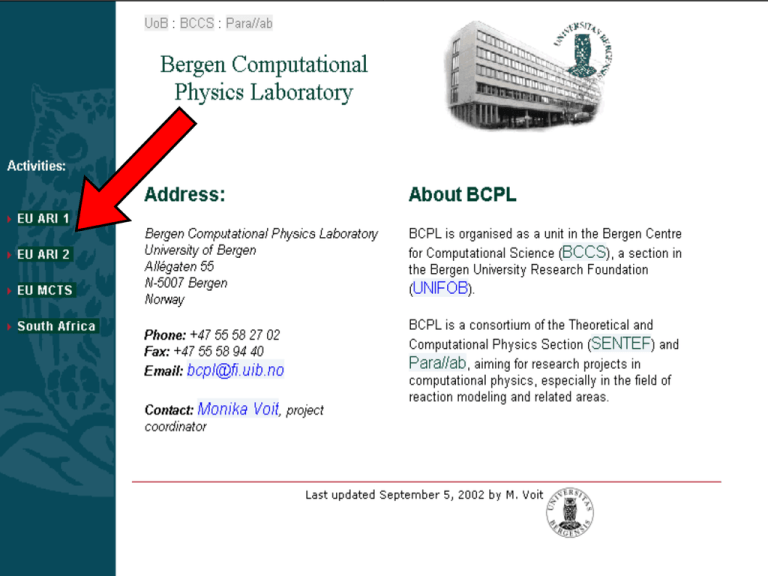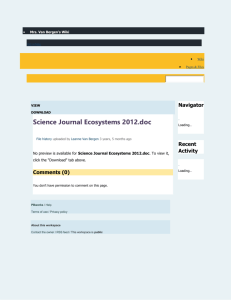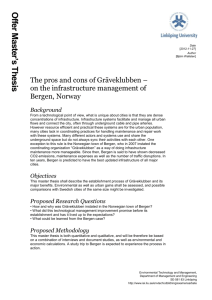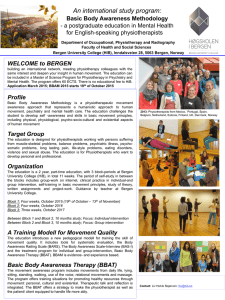BCPL-Rep-Trento03
advertisement

Bergen Computational Physics Lab 1 ~ 50 projects Bergen Computational Physics Lab ~ 100 visitors 2 Project Hosts (BCPL) Name Anderlik, Csaba Csernai, Laszlo P. Hansen, Jan-Petter Hansteen, J. M. Helstrup, Haavard Kocbach, Ladislav Osnes, Eivind Rohrich, Dieter Stamnes, Jakob Vaagen, Jan S. Prof. U of B Ph.D. 2001(+) Univ. of Bergen, 2001 1987 Eotvos U. Budap. 1976 1999 Univ. of Bergen, 1990 1985($) Univ. of Bergen, 1976 2001(?) Univ. of Bergen, 1993 1993 Univ. of Bergen, 1977 1985(#) Univ. of Oslo, 1966 1999 Univ. of Marburg, 1986 1990 Univ. of Oslo, 1975 1993 Univ. of Bergen, 1977 Publ. # ISI Citations ISI'02 6 101 56 27 51 39 98 72 54 96 51 2116 470 (*) 1013 646 974 1088 1853 1039 1248 (+) Senior Scientist ($) Professor emeritus (#) Prof. Univ. of Oslo (?) Prof. Bergen Univ. College (*) For JP Hansen citations that could not be traced back to the original by the ISI WoS trace program are not counted, because of the large number of citations (800+) to authors with the same name and initials. Bergen Computational Physics Lab 3 BCPL Technical Review’02 - 14 yes of 14 questions: 100% result. Some comments: - Many institutions would like to have 92% of their users happy with what they provide and judging that the Lab is "extremely good and managed in an optimal way'. More importantly, users claim that they achieve their scientific goals and publications demonstrate that the achieved goals are of high scientific value. - 99% of users believe that they would not achieved the same results without the access to the infrastructure and all are thankful to the European Community for providing the scientific and financial support through the ARI programme. -The Bergen Computing Physics infrastructure is world-class in the topics of atomic, molecular, nuclear and particle reaction modeling. It combines parallel computer power and theoretical physicists and therefore offer an exceptional scientific environment to develop high quality research projects. -The quantity of access is 15% more than the foreseen number. This is justified by the change of computing facility : the Turbo Regatta supercomputer is faster than the previous machine. Bergen Computational Physics Lab 4 Bergen Computational Physics Lab 5 Highlights of BCPL achievements in 2002 Since January 2000 up to now BCPL has received 55 project proposals has accepted 53 projects for EU support from the beginning of yr. 2000. So far, near to 100 researchers visited BCPL. Although we did not receive additional financing from the EU to cover the excess demand, we did accommodate 16.6% more visitors, than our first contract planned. We did not run out of EU financing: by saving on the expenses of the user meetings held at ECT* in Trento Italy, and taking advantage of our new IBM machine with 12.8 times increased power. As a consequence we managed to transfer 7.5% of our budget from the User Travel to the User Fee part, and so we stayed within the limits of our EU financing. Bergen Computational Physics Lab 6 In year 2002 we hosted researchers for 19 projects, spreading over particle, high and low energy nuclear, atomic, plasma and molecular physics, and extending to related fields in astrophysics as well as abstract statistical physics problems for self avoiding walks and clusterization phenomena in sociological systems. Most projects belong to BCPL’s core activity of reaction modeling in different areas, 3-4 projects are related or abstract problems. A smaller part of the projects were continuing from the previous year. In this report only a fraction of the projects can be mentioned with important and recent results. The projects are grouped in thematic classes, as some of them are strongly related. Bergen Computational Physics Lab 7 PARTICLE PHYSICS In the project “Three-body initial states in charmonium dissociation” (project no. 46) from Sylesian University, Czech Republic, led by P. Lichard, the main goal of the whole project was to calculate the contribution to the charmonium dissociation from the three-initialmeson reactions in a hadron gas. It was neccessary to determine the propagators and couplings of resonances before actual calculations of the reaction rates. During a short initial stay in Bergen the running masses of vector mesons, rho and Kstar, were determined by means of the dispersion relations. A good test in the rho meson case was a perfect agreement between the calculated and experimental value of the electromagnetic mean square radius of pion. It is well known that the usual fixed mass parametrization of the rho meson propagator badly fails in this test. This work will be utilized later to calculate possible hadronic background effects to the charmonium suppression in Quark-gluon Plasma. Bergen Computational Physics Lab 8 HIGH ENERGY SUBATOMIC REACTIONS Projects 34-38, 44, addressed these reactions with microscopic transport models, while 29, 40, 43; used continuum or CFD approaches to evaluate the collective effects in these reactions. Project 29 was actually an important methodical advance, which introduced the use of different modules in a reaction model and established an exact physical interface among the modules. This enables later to create more involved modular reaction models, which can take advantage of GRID computing. Projects 34 and 36 worked on important parts of reaction models, on Meson-Nucleon Scattering (no. 34, KFKI, Budapest, by G. Wolf) and on Meson Production (no. 36, ELTE, Budapest, by G. Papp). The latter project has advanced considerably, so the results could e used for jet calculations in heavy ion reactions. The results obtained this way were published in two conference reports and in two papers. Bergen Computational Physics Lab 9 HIGH ENERGY SUBATOMIC REACTIONS contd. Two German projects, no. 38 and 44, led by A. Faessler, Tuebingen and F. Puelhofer, Marburg respectively, simulated heavy ion collisions by the QGSM and UrQMD models. These projects performed a comprehensive analysis of a large number of observables, which enables us to make a complex assessment of the experimental observations. Project 43 on “Relativistic Hydrodynamics for Heavy Ion Collisions” by H. Stoecker, & D. Strotman, Frankfurt, Germany, is a comprehensive model development work for extending the CFD approach to Ultrarelativistic, BNL - RHIC and CERN – LHC energies. Here already the possible Modular Modeling approach and possible task sharing is taken into consideration. Project 29, led by V. Magas, Lisbon, Portugal was working on the interface between the CFD module of the reaction simulation and of the so-called Freeze Out module. This module describes the stage of the reaction where mechanical, thermal and chemical equilibrium ceases to exist at the end of the reaction, and the final observables develop. Bergen Computational Physics Lab 11 ASTROPHYSICS In project 42 on “Cooling of Extremely Compact Stars” led by Z. Stuchlik of Silesian University, Opava, Czech Republic, the study of neutron, quark, and hybrid stars was concentrated on diverse topics leading to the problem of cooling of extremely compact stars. The group worked with the preparation of a numerical code for cooling processes in extremely compact stars with realistic equations of state. They also considered hybrid stars with two-flavour quark cores, or three-flavour, strange quark cores, and discussed the possibility of a "cascade" evolution of a neutron star to a hybrid star with succesively two-flavour, and three-flavour quark cores as a result of accretion of matter onto the neutron star. For simplicity, the phase transition between the nuclear matter and the quark matter was considered to be of the first kind. A numerical code for selfgravitating polytropic and adiabatic fluid spheres taking into account the influence of a nonzero vacuum energy has been developed during our stay at BCPL. As a result of these and previous works a paper concerning the mixed influence of a nonzero vacuum energy (leading to both a repulsive or an attractive effective cosmological constant) and an electric charge on the character of black holes and naked singularities has been finished. Bergen Computational Physics Lab 16 STATISTICAL PHYSICS contd. An interesting and very abstract idea is the base of project 45 by Z. Neda, of Cluj, Romania: “Statistical physics approach to clusterization phenomena in sociological systems”. The aim of the project was to study a spin-glass type frustrated model for coalition formation in sociological systems. Our main approach to this NP hard optimization problem leads through the classical methods of statistical physics using Monte Carlo optimizations. Two type of algorithms are used: (i) the classical simulated annealing method and (ii) the recently reported extremal optimization approach. Both methods are rather time-consuming, and high parallelization of the code is desired. Our results suggest that a globally coupled large system with +/interactions between the elements, has two marginal behaviors. When the + links number dominate over the - links number in the optimal situation the system will clusterize in a single large cluster. When the - links number is bigger, the systems splits in as many clusters as many elements there are in the system. This transition resembles the one obtained in percolation type problems, and gives a hint that the model can be used effectively to study the so-called "social-percolation" problem too. Bergen Computational Physics Lab 18 CONCLUSIONS of the SCIENTIFIC REPORT The selected projects give a taste of the variability of BCPL's research projects. Most projects were fully successful and achieved their goal. A few projects plan for a continuation. The offered computational power to EU-RI user groups is increased by a factor of 12.8 from the beginning of 2002 by installing an IBM eserver supercomputer (For the same access charge to the EU as before!). At the time of the installation it was the 6th most powerful supercomputer in Europe. We are preparing for the FP6 applications now. We apply as an individual RI for providing Transnational Access just as before but for more users (~40 man-months per year). In addition we participate in several I3, RI-network applications. We also apply for a Marie Curie Early Stage Training Site. In the Thematic programs under the IST and Nanotechnology and nanoscience subjects corresponding to our 3 Expressions of Interest submitted to the EU in June 2002. Bergen Computational Physics Lab 19 PRESENT ACTIVITIES: Modeling Subatomic, Atomic & Molecular Reactions CONSULTING & SUPERCOMPUTER ACCESS EU FP5 TARI no. 1 (2000-2002) ----- EUR 396 000 . – EU FP5 TARI no. 2 (2003-2004/2) --- EUR 175 000 . – EU FP5 MCTS (2001-2004) ------ EUR 242 000 . – South Africa (2002-2005) ------- EUR 160 000 . – Rolls-Royce/HFK / 2003 - ------ Bergen Computational Physics Lab pending 20 BCPL plans for FP6/RI programme BCPL I3HP / CSERNAI Single RI for offering I3NS / VAAGEN I3Atom / HANSEN Transnational Access I3HPC / ANDERLIK I3 Member for: - Networking and - Joint Res. Projects [ RI rules would not allow for BCPL to provide access from four I3-s, while networking and JRP participation is OK.] Bergen Computational Physics Lab 21 Other BCPL Proposals to EU • • • • • Bergen-Nano-Phase NoE (N) / 6.03.03 MC Early Stage Training Host /2.04.03 BCPL Research Infrastr. / 15.04.03 Bergen-Dist-Comp IP (IST) / 24.04.03 Bergen-Heavy-Ion NoE (IST)/ Fall 03 /Csernai /Csernai/Voit /Csernai /Anderlik, D.R. /Anderlik, Csernai • Participation: I3 activities 3-4 / Csernai, Vaagen, Hansen, Anderlik • Participation: TIME (N) / coordinated by F. Shauer (CZ) • ??? Bergen Computational Physics Lab / Anderlik, Csernai 22




